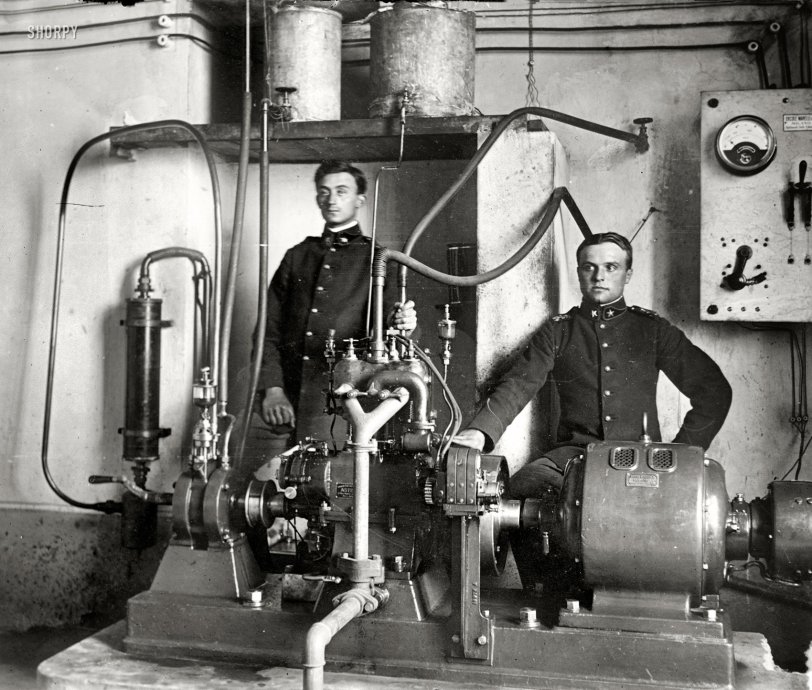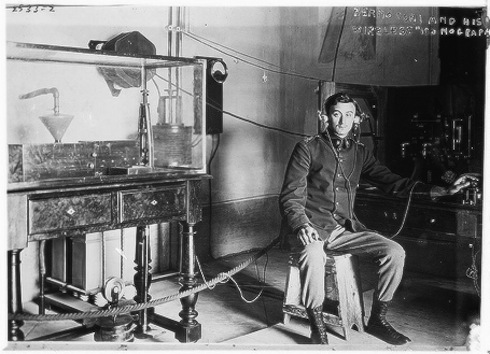


Framed or unframed, desk size to sofa size, printed by us in Arizona and Alabama since 2007. Explore now.
Shorpy is funded by you. Patreon contributors get an ad-free experience.
Learn more.

- Illuminate us
- I remember it well
- I can't prove it
- Complicated then, forgotten now
- Bryan-Stevenson
- Skinny is as skinny does
- How do you rest in peace
- Riding the footboards
- Alas, hidden from view
- Baldwin Diesels
- Exclusive pump
- Bananas, Oysters and Smokey Joe
- Details, Details
- What's that building to the left of the tower?
- Coal Barges
- Bromo-Seltzer
- Inner harbor
- The Basin
- What a headache!
- Giant stepladder?
- Yeah, it was cold
- Love those coats
- Link & Pin Days Remnant
- Baldwin 62303
- Baldwin VO-1000
- Cold
- No expense spared
- Tough Guys
- What's your hurry, where's your hat?
- Sheriff's Signature
Print Emporium
Wireless Iconograph: 1912

Turin, Italy, circa 1912. "Bernocchi (left) and wireless iconograph." The inventor Francesco de Bernocchi and his fax-like device, which by means of "Hertzian waves" was said to facilitate the "exact wireless transmission of messages, sketches, autographs, shorthand and other signs, with a secrecy hitherto unattained." Bain News Service glass negative. View full size.
Engine Dynamometer
That's an engine dynamometer. The 2-cylinder engine on the left is driving a generator. The system can add generator resistance to hold back the engine. In other words, the generator is a "brake" used to hold the engine at specific rotational speeds (revolutions per minute--RPM) and torque readings are taken at each speed. The data are plotted to construct curves. Horsepower is calculated from the torque data. Result is therefore called brake horsepower, or BHP.
I'd need a bigger computer armoire
Fascinating to know such a thing even existed then. When I worked in newspaper in the Jurassic Period, we had a scanner that occupied a two-story space about 50 feet by 125 feet. It was used primarily for optical character recognition of writers' copy. You had to type your news stories on special red and white forms. No errors allowed as there was no software in existence to edit what went in.
I'm a goood tpyits butit droev me nust.
Covered in Popular Mechanics
Found this in the Google archives.
That generator
may be an alternator. Alternators wre used early in the radio art to transmit modes that needed "continuous wave" radio frequency carriers, as opposed to the "damped wave" signal produced by spark transmitters.
An electric motor turned the alternator and the RPM determined the frequency. The speed of the motor was therefore tightly regulated.
Alternators had much cleaner output than spark transmitters and could produce tremendous power.
Other features-
I'll bet it could make a good chocolate milkshake too!
I think you got the names wrong
Which one's Rube and which one's Goldberg?
Where's the Rest?
OK now...we see the power plant and what looks to be a generator and a switchboard, but where's the "Iconograph"? Maybe the device on the left side of the engine?
Doesn't even look close to a wireless getup.
I see a two-cylinder engine hooked up to some sort of generator or motor, plus a lot of tubes and hoses, but no drum on which to put the imagery.
I wonder why nothing came of this
He got a write up in The New York Times on this, but I don't find too much else.
My, we've come a long way
Imagine how big your desk would have to be to hold THAT fax machine!

























On Shorpy:
Today’s Top 5